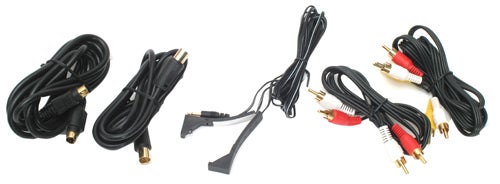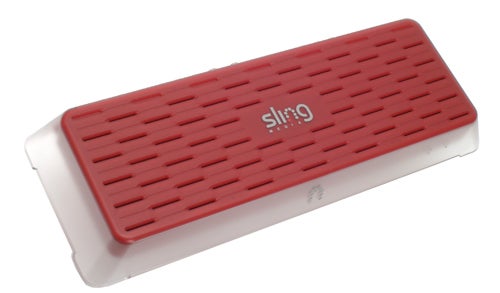Sling Media Slingbox Pro Review
Sling Media Slingbox Pro
SlingMedia updates its SlingBox line but is it a worthy successor?

Verdict
Key Specifications
- Review Price: £183.20
Just over a year ago, Sling Media arrived on the scene with a refreshingly simple but innovative technology – the Slingbox. This introduced to a mainstream audience the concept of place-shifting as the Slingbox let you watch your TV from anywhere you had access to the internet, whether that be in another room in your house, or in another country.
Since the launch of the original box, there have been several software updates and the Mac support that was absent at last year’s launch is now present and correct. The PDA and smartphone support I wished for in the original review has now materialised, as long as you’re got a Symbian powered phone, such as the Nokia N95 or one that uses Windows Mobile. The Palm Treo is also supported, though only the 700p, 755p and the new Palm Centro. There’s talk that a Java and RIM Blackberry based version might be in development, but nothing has been announced so far
Now, while the US has enjoyed several follow ups to the original box, Europe has not – until now. The Slingbox Pro appeared late last year in the States, but now the PAL, Freeview equipped and suitably British version has arrived. What the Pro offers over the original, now named the Classic, is the ability to connect more sources, with the S-Video input of the original joined by composite and component via an external break out box. As before you can also connect up an aerial to the in-built Freeview tuner.
Design-wise the Slingbox Pro has had a bit of an overhaul. Out goes the silver Yorkie-like look and in comes a red coloured box shrouded in a smoky plastic cover and I think it’s an improvement. However, if you don’t care for the looks once you’ve got it all set up you can hide it away out of sight.
Set up is actually quite straightforward and a guide is there to be laid out on the floor and followed to get you up and running. All of the cables that you might need are included in the box, so if you take your time you could be up and running in a few minutes. One thing that many might have expected Slingbox to have added is support for Wi-Fi – but it has refrained from doing so with the Pro. The downside of this is that if your router is not in the same room as your input sources then you’ve got a problem. One way round this is a wireless gaming adaptor or some type of Powerline or HomePlug networking device, which uses your electricity supply to create a network. Slingbox itself has a £70 SlingLink Turbo bundle, which is 85Mbps Home Plug based, with a Slingbox-like design, though any brand will do fine. Also included in the box is an IR Blaster designed to attach to the top and bottom of your source enabling it to pick up the remote control commands – the Slingbox is about controlling your home TV from wherever you are and not just watching.
The break out box can accept HD sources at 720p or 1080i, though not 1080p. It connects to what looks like an HDMI port, but in fact it’s just a proprietary port, which could cause some confusion as some might try and hook up an HDMI connector directly to it. One limitation I should mention straight away is that this does not mean you can stream in HD resolution – the maximum is 640 x 480, though the top bit-rate that the Slingbox can process has now increased to 8Mbs, which should provide a good boost in quality.
If you want or need to use a SCART connector then you get an adapter, which will convert you SCART plug into a composite output, while still enabling you to pass through your SCART plug to whatever it was originally connected to, which is good. Unfortunately, you won’t be able to get an RGB signal from a SCART output into the Slingbox, it’s composite only, which means you’ll need to drop down slightly in quality to S-Video unless your source has a component input. All the inputs now have pass throughs too, so you don’t have to disconnect them from the outputs they were previously connected to. The larger size of the Pro means that the Slingbox now has room for full size phono audio connectors, which should make installation in an AV system a little easier. 
There are two small lights on the Slingbox, one which tells you’ve got power, and the other when you’re connected to the network. It should be a solid light for both but for some reason at first I got a flashing light on my network connection. However, holding down the reset button cleared the error, and all was well.
One thing you won’t find in the box is a software CD. Sling Media updates the software frequently and it makes sense to make punters just download it when they set up. A wizard picks up the Slingbox on your network and the first time you’ll be asked to give it an individual name, and create a password to access it, and another one to set up an administrator account who can make changes to the set-up. Assuming you’ve plugged in everything where it should be you should straight away see a picture in the wizard from your source. You then tell the software what the source is, and the chances are that full remote control codes for it will appear in Sling Media database. After this, the Sling Player software will show a virtual version of the remote with pressable buttons so you can control the source as if you were in the same room. For something like a Sky + box you’ll get an exact virtual replica, but for something a little less ubiquitous you’ll get a generic remote.
Once you’ve set up one input, you can them move onto the next one, and before long I had set up my Sky + box, my DVD player and the integrated Freeview box. Now with only one IR Blaster input on the Slingbox I had expected that I would be able to only control my Sky box and not my DVD player. However, my DVD player happens to be placed right underneath my Sky box, and remotely controlling the DVD player worked flawlessly. However, if your two devices aren’t close to each other then you’ll have to decide which one you want to be able to control, which is a shame. A second remote IR blaster port would solve this problem, though it would add to the already healthy maze of wires you need to deal with. With the DVB-T tuner being built in, there’s no such issues with that. Controlling a DVD player remotely actually might seem rather pointless for most people as you’ll only have the one disc in there, but it makes more sense if you’ve got a DVD recorder with mucho content on its hard disk.
As with the previous version, the SlingPlayer is the software you watch on. By default it has SlingStream technology enabled, which optimises the bit-rate of the picture for the bandwidth that’s available. When you’re watching in the LAN, and there’s plenty of bandwidth available you can get simply fantastic results. It starts of low and slowly the bit-rate meter will increase until it’s really flying. It takes a while but eventually you’ll be past the old 2Mbps limit. At 5Mbps, House of Flying Daggers streamed over the LAN looked simply fabulous. So if the wife’s watching Shmuck Factor: Britain’s Next Top Celebrity Irritant, I can instead retain my sanity watching that DVD I’ve been meaning to get to for a while or even the football, should there be anything on terrestrial that Sky hasn’t hoovered up. The Mac support also works well, even on an older G4 Mac mini, as I can attest to, as I sat watching Lewis Hamilton throwing away the championship in Brazil. 
Not having Sky HD, back in the office I hooked up an Toshiba HD-XE1 HD DVD deck and tried out the component input. To be honest at a maximum resolution of 640 x 480, the quality was only just as good as a DVD. Of course the HD DVD drive wasn’t in the database so I couldn’t control it remotely but the component input is really for hooking up HD set-top boxes. I couldn’t imagine someone would bother hooking up a Blu-ray or HD DVD player normally. Of course, with the component taken up by the HD set top box, your DVD player or media centre would be limited to an S-video source. If you’re source has access to a large amount of content your Slingbox Pro could really give you a lot of content choice when you’re out on the road or in another room.
Out of the local LAN the quality of the stream does inevitably degrade. You need a broadband connection with at least a 256Kbps upload, but more will naturally give you better quality, as long as your local download is up to it. I tested on a slower 384Kbps 3G data card, and quality certainly suffered, at around 90Kpbs, which isn’t really enough for fast action, but adequate for the news.
Connecting to your Slingbox out of the LAN is very simple if you have a router that can support UPnP, (Universal Plug and Play), which most modern routers do. This enables the Slingbox to configure the router to open the necessary ports and then communicate with the Slingbox servers automatically so that when you type in your Slingbox name it can always be found. Those, who wish to set things up manually however, can do so. I tested on Windows Mobile too, using an HTC Touch, and for some reason was forced to manually enter in the full Finder ID as well as my Slingbox name, which took a stupid amount of time. Once done though, I was again impressed with the quality over Wi-FI , with a full, smooth and pleasingly detailed image.
All in all, it was nice to be reunited with the Slingbox, and I found that it has nicely moved on in the year since it first launched. The lack of wireless is a shame in one sense, but does actually simplify things once you’ve got round the problem and ensures reliability. You also need to be sure that you need all those inputs, other wise the SOLO might be the better choice. The Slingbox classic can still be picked up but production has ceased, so it will disappear before too long. Having multiple inputs at my disposal though really enhanced the product, though if you’re sure you’ll only want to Sling from one source, then the new, cheaper and more stylishly designed Slingbox SOLO will suffice. Personally, not having Freeview would be a deal breaker for me, but the choice is there.
”’Verdict”’
The Slingbox Pro has improved on the original in every respect. It’s smarter on the outside, and smarter on the inside too. The increase in inputs adds flexibility, specifically the addition of component input. The increase in maximum quality is tangible, and platform support is good too, on Windows, Mac and some smartphones. The Slingbox Pro is a class act, and a great way of distributing your TV.
Trusted Score
Score in detail
-
Value 8

